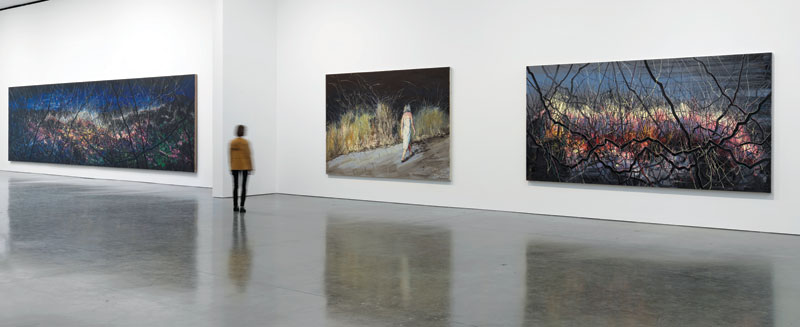« Reviews
Zeng Fanzhi: Paintings, Drawings, and Two Sculptures
Gagosian Gallery - New York
By Taliesin Thomas
The contemporary Chinese art world seems increasingly defined by two major themes: the potential of materiality and the seduction of capitalist motives. Among his peers, Zeng Fanzhi (曾梵志; born 1964 in Wuhan) commands both sides of the spectrum. While Zeng’s work demonstrates an authority over the medium of oil paint, his status as China’s number-one blue-chip artist has been holding steady for several years. In October 2013, Zeng’s painterly rendition The Last Supper (2001) sold for $23.3 million U.S. at Sotheby’s Hong Kong, setting a world record for a contemporary Asian artwork sold at auction that has yet to be broken. The legendary biblical scene reconfigured by Zeng includes masked figures eating watermelons at a pristine white table with calligraphic scrolls flanking the walls behind them.
His first solo show at Gagosian Gallery in New York, “Zeng Fanzhi: Paintings, Drawings, and Two Sculptures,” presents exactly what this title indicates while simultaneously disclosing the precarious power of an artist whose reputation has reached a considerable zenith. This exhibit offered a sublime encounter with works that reveal his current focus on large-scale portraiture and abstraction. Now a mid-career artist, Zeng’s early paintings conjure haunting, psychological qualities that evince a distinctly Freudian influence and style, both in terms of Freud, the father of psychoanalysis, and his theories concerning the depth of the human psyche, as well as the muscular energy of his grandson, the painter.
The emotional intensity of Zeng’s work has morphed over time; his move from rural Hubei province to cosmopolitan Beijing in the early 1990s marked a distinctly new direction for his art. Evolving from visions of macabre hospital scenes depicting human wreckage and paintings of bloody, butchered meat to portraits of stoic, sophisticated figures clad in Western suits and often wearing white masks, Zeng’s art often reflects his concentrated exploration of the unconscious. Similar to other contemporary Chinese artists of his generation, Zeng channels the complexities of China’s collective soul to bring forth a slightly melancholic vision of alienated individuals struggling for new definitions. The difference, however, is that while some Chinese artists tend to drop a sociopolitical punch line vis-à-vis their art, Zeng’s work leaves us hanging in the existential void. The formidable painting Blue (2015), for example, transports us into visual bliss through a wrangle of thorny branches. If Zeng’s earlier figurative work suggests an examination of strange experiential situations, his latest paintings turn us toward the transcendent.

Installation view of Zeng Fanzhi: Paintings, Drawings, and Two Sculptures. Image credit: Artwork © Zeng Fanzhi Studio. Photography by Rob McKeever. Courtesy Gagosian Gallery, New York.
The cavernous space of Gagosian Gallery featured several monumental semi-abstract landscapes and scenes of lone figures peering into the bleak distance. The massive work This Land So Rich in Beauty No. 1 (2010) expanded across the wall (at a whopping 98-by-413 inches) and its deep, dark color scheme stretched even further into the metaphorical abyss. Although his latest work is distinctly expressionistic, Zeng’s art also echoes with a feeling of emptiness reminiscent of ancient Taoist philosophy. The Tao concedes that mystery and manifestations arise from the same source of darkness; considering Zeng’s latest exhibition, one might agree.
(November 6 - December 23, 2015)
Taliesin Thomas is a Brooklyn-based artist, writer and philosopher who has worked in the field of contemporary Chinese art since 2001 after living two years in rural China. Thomas holds an M.A. in East Asian studies from Columbia University, and she is currently a Ph.D. candidate in art theory and philosophy at the Institute for Doctoral Studies in the Visual Arts. She is the founding director of AW Asia in New York.
Filed Under: Reviews



































Leave a Reply
You must be logged in to post a comment.